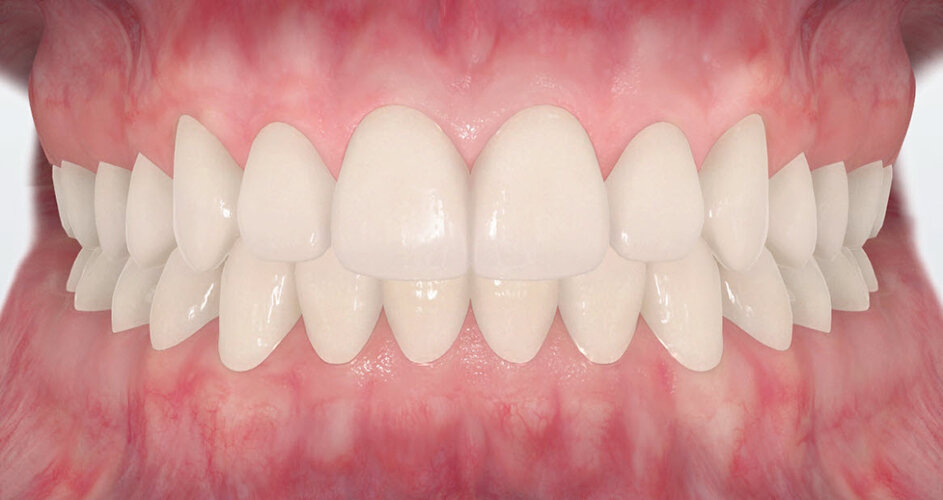What Causes Dark Triangles Between the Teeth?
Why do some patients have little dark triangles (spaces) between their teeth before, during, or after orthodontic treatment? In an ideal smile, teeth are aligned in a smooth row with each tooth touching the one next to it and healthy gum tissue in between. After treatment, some patients notice that the gum tissue between their teeth doesn’t look the same as it did before. Why is that? Does orthodontic treatment change the shape of the gum tissue? Can anything be done to correct or improve it?
There are two variables related to the presence of dark triangles
The place on the teeth where they touch each other when they are side by side is called the “contact.” The area below the contact is called the “embrasure.” The gum tissue that normally fills the embrasure is called the “papilla.” When the papilla completely fills the embrasure, you cannot see light between the teeth. When contacts are touching but the gum tissue doesn’t completely fill the embrasure, there is a space or a dark triangle between the teeth under the contacts. The presence of dark triangles is affected by two things, 1) the shape of the teeth, or 2) the shape and size of the papilla.
The shape of the teeth determines how tightly they can fit together
If the teeth are rectangular in shape, their flat sides lay side-by-side with little or no space between them. If the sides are more rounded, or if the teeth are triangular in shape however, the embrasure is larger and more likely to appear as a space if the gum tissue isn’t ideal. There are two procedures that can be done to help reduce or eliminate dark triangles that exist because of poor tooth shape. First, your dentist may be able to change the shape of the teeth by veneering or bonding them. This can make their sides flatter so they lie closer together. The other procedure involves reshaping or filing the sides of rounded or triangular teeth so that they are flatter and can be moved closer together. This procedure is officially referred to as “interproximal reduction” or “reproximation.” It can be performed by your orthodontist who is trained to know how much enamel can safely be altered without causing problems.
The shape and size of the gum tissue also affects dark triangles
The other factor related to the presence of dark triangles is the shape and size of the papillae between the teeth. When we are young, our gums are taller between the teeth and they usually completely fill the embrasures. As we get older, the height of our gum tissue naturally decreases and triangular spaces begin to appear, even between straight teeth in healthy mouths. Teeth that are well-aligned have room for normally shaped gum tissue between them. Crooked teeth often overlap such that there is no room for papilla between them. In these cases, aligning the teeth exposes the fact that there wasn’t gum tissue between them to begin with. For this reason, many patients mistakenly believe that their orthodontist caused the dark triangles. In reality, he merely uncovered the fact that there were no papillae between the overlapping teeth to begin with.
Even though a periodontist can perform soft tissue grafts in other areas of the mouth, adding individual papilla is not possible at this time. Even if the teeth are fairly normal in shape, interproximal reduction in patients with dark triangles can improve the appearance of a smile. For more information on interproximal reduction, please see my previous article called "What Is Interproximal Reduction in Orthodontics?"
NOTE: The author, Dr. Greg Jorgensen, is a board-certified orthodontist who is in the private practice of orthodontics in Rio Rancho, New Mexico (a suburb on the Westside of Albuquerque). He was trained at BYU, Washington University in St. Louis, and the University of Iowa in the United States. Dr. Jorgensen’s 25 years of specialty practice and nearly 10,000 finished cases qualify him an expert in two-phase treatment, extraction and non-extraction therapy, functional orthodontics, clear aligners (Invisalign), and multiple bracket systems (including conventional braces, Damon and other self-ligating brackets, Suresmile, and lingual braces). This blog is for informational purposes only and is designed to help consumers understand currently accepted orthodontic concepts. It is not a venue for debating alternative treatment theories. Dr. Jorgensen is licensed to diagnose and treat patients only in the state of New Mexico. He cannot diagnose cases described in comments nor can he select treatment plans for readers. Because he has over 35,000 readers each month, it is impossible for him respond to all questions. Please read all of the comments associated with each article as most of the questions he receives each week have been asked and answered previously. The opinions expressed here are protected by copyright laws and can only be used with written permission from the author.


